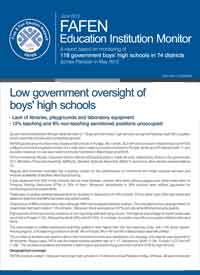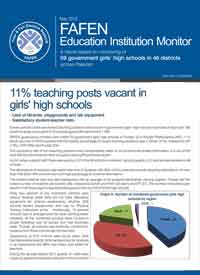- Lack of libraries, playgrounds and laboratory equipment
- 12% teaching and 8% non-teaching sanctioned positions unoccupied
- A report based on the monitoring of 118 government boys’ high schools in 74 districts across Pakistan in May 2012
ISLAMABAD, June 14, 2012: Government and elected officials made 58 visits to 118 government boys’ high schools during the February-April 2012 quarter, which meant 60 schools were completely ignored, says a Free and Fair Election Network (FAFEN) report.
FAFEN governance monitors observed schools in 74 districts. They found the most visits (41) were made to schools monitored in Punjab. Sindh and KP followed with 11 and six visits. However, no visit was made to schools in Balochistan and FATA.
According to the report released Thursday, 48 schools were monitored in Punjab, 38 in Sindh, 30 in KP and one each in Balochistan and FATA in May.
Of the monitoring officials, Executive District Officers (EDOs/Education) made 30 visits, followed by others in the government (21), Members Provincial Assembly (MPAs/5), Member National Assembly (MNA/1) and some other elected representative (1).
Regular and informed oversight has a positive impact on the performance of institutions and helps improve services and ensures availability of facilities often found lacking.
It was observed that 43% of the schools did not have libraries, another 40% were without playgrounds while there were no Physical Training Instructors (PTIs) in 32% of them. Moreover, laboratories in 20% schools were without apparatus for conducting science experiments.
There were no proper seating arrangements for students in classrooms of 19% schools. On the other hand, 90% had chairs and tables for teachers and 96% had black and white boards.
Classrooms of 96% schools were clean although 83% had employed sanitary workers. This indicated ad hoc arrangements for cleanliness had been made in 13% schools. Moreover, there were peons in 97% schools while 95%had security guards.
Eight percent of the sanctioned positions of non-teaching staff were lying vacant. The highest percentage of vacant posts was recorded in Punjab (11%), followed by Sindh (9%) and KP (3%). In contrast, no position was left unoccupied in Balochistan and FATA.
The percentage of unfilled sanctioned teaching positions was higher than the non-teaching ones, with 12% posts vacant. Among regions, 21% teaching positions in Sindh, 9% in Punjab, 8% in KP and 6% in Balochistan were left unfilled.
The number of students-per-teacher ratio in the monitored schools was satisfactory. On average, one teacher was assigned to 26 students. Region-wise, FATA had the lowest teacher-student ratio of 1:17, followed by Sindh (1:25), Punjab (1:27) and KP (1:28). The number of students-per-teacher in each region was below the government set limit of 50 for high schools.
To download complete report, click here




